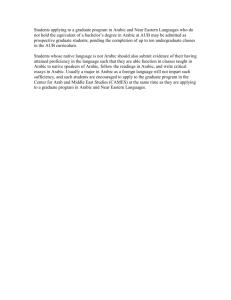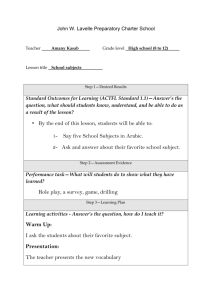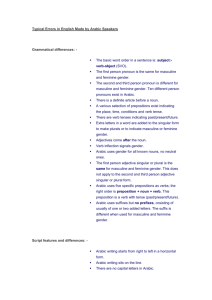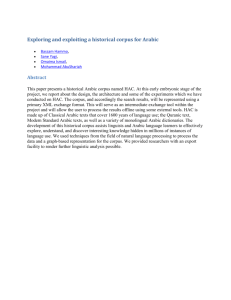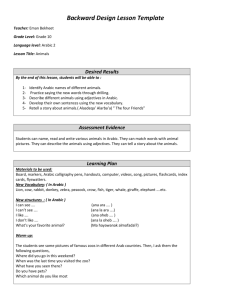Licensing Movement and Feature Checking in
advertisement
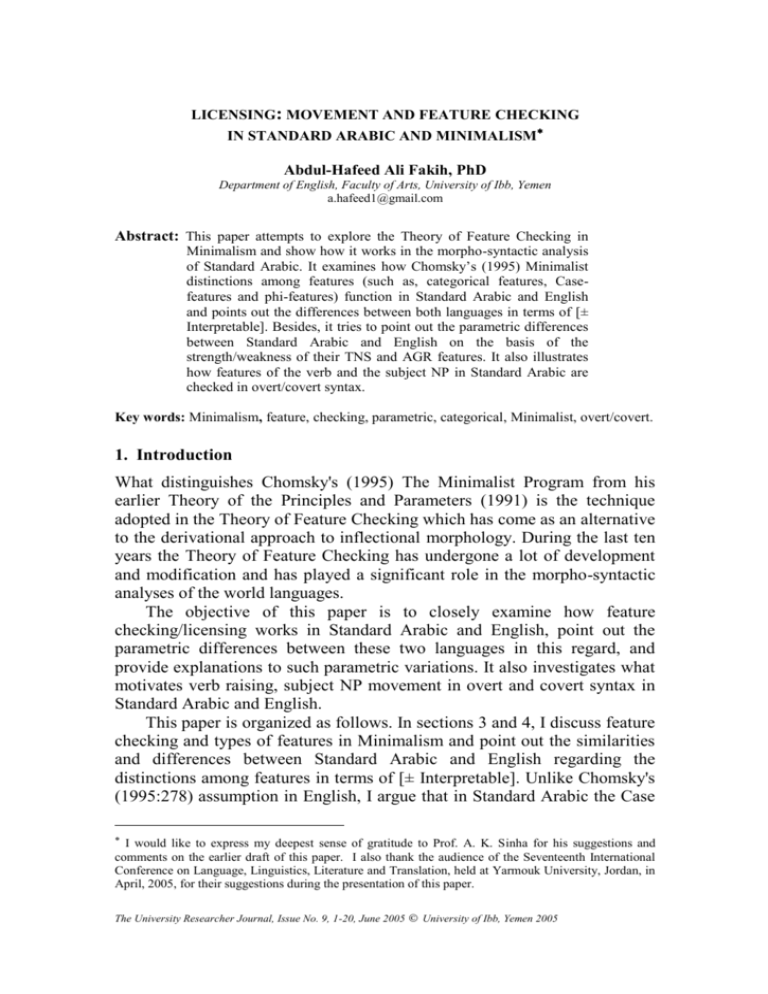
LICENSING: MOVEMENT AND FEATURE CHECKING IN STANDARD ARABIC AND MINIMALISM Abdul-Hafeed Ali Fakih, PhD Department of English, Faculty of Arts, University of Ibb, Yemen a.hafeed1@gmail.com Abstract: This paper attempts to explore the Theory of Feature Checking in Minimalism and show how it works in the morpho-syntactic analysis of Standard Arabic. It examines how Chomsky’s (1995) Minimalist distinctions among features (such as, categorical features, Casefeatures and phi-features) function in Standard Arabic and English and points out the differences between both languages in terms of [± Interpretable]. Besides, it tries to point out the parametric differences between Standard Arabic and English on the basis of the strength/weakness of their TNS and AGR features. It also illustrates how features of the verb and the subject NP in Standard Arabic are checked in overt/covert syntax. Key words: Minimalism, feature, checking, parametric, categorical, Minimalist, overt/covert. 1. Introduction What distinguishes Chomsky's (1995) The Minimalist Program from his earlier Theory of the Principles and Parameters (1991) is the technique adopted in the Theory of Feature Checking which has come as an alternative to the derivational approach to inflectional morphology. During the last ten years the Theory of Feature Checking has undergone a lot of development and modification and has played a significant role in the morpho-syntactic analyses of the world languages. The objective of this paper is to closely examine how feature checking/licensing works in Standard Arabic and English, point out the parametric differences between these two languages in this regard, and provide explanations to such parametric variations. It also investigates what motivates verb raising, subject NP movement in overt and covert syntax in Standard Arabic and English. This paper is organized as follows. In sections 3 and 4, I discuss feature checking and types of features in Minimalism and point out the similarities and differences between Standard Arabic and English regarding the distinctions among features in terms of [± Interpretable]. Unlike Chomsky's (1995:278) assumption in English, I argue that in Standard Arabic the Case I would like to express my deepest sense of gratitude to Prof. A. K. Sinha for his suggestions and comments on the earlier draft of this paper. I also thank the audience of the Seventeenth International Conference on Language, Linguistics, Literature and Translation, held at Yarmouk University, Jordan, in April, 2005, for their suggestions during the presentation of this paper. The University Researcher Journal, Issue No. 9, 1-20, June 2005 © University of Ibb, Yemen 2005 LICENSING: MOVEMENT AND FEATURE CHECKING 2 features of V and T are intrinsic and [+ Interpretable], hence not eliminated at LF. I also argue that, unlike English, the Ф-features of V and adjective are [+ Interpretable] in Standard Arabic morpho-syntax. In section 5, I explore the parametric differences between Standard Arabic and English and show that the differences in the functional features attached to the lexical elements can best be explained in terms of their functional category nodes which can also explain the differences in the word order in these two languages. I also discuss how the ordering of the functional elements TNS and AGR differs in Standard Arabic and English. I draw the generalization that TNS c-selects AGR in Standard Arabic while in English AGR c-selects TNS. I propose that the TP projection should immediately dominate AGRsP in the clausestructure of Standard Arabic. In section 6, I examine movement and feature licensing and show why verb raising is always overt in Standard Arabic and why it is covert in English. In section 7, I discuss how the three major economy principles work in Standard Arabic and English. I also show why the overt raising of the subject NP in Standard Arabic is barred by the principle of Procrastination. 2. Introducing the Minimalist Program (1995) The Principles and Parameters Theory of Chomsky (1981,1991) was assumed to consist of principles and parameters; the former are languageindependent universal laws, while the latter (i.e., parameters) capture real differences among languages. It is assumed that there is a finite number of parameters, and each parameter has a finite number of values. The attempt was to have a unified explanatory theory for the apparent unlimited diversity of languages. The Minimalist Program of Chomsky (1993,1995), (henceforth the MP) is the most recent outgrowth of the ongoing inquiry in this field. The unique characteristic of the MP is the attempt to explain language phenomena through the well-known method of minimization. The goal is to minimize constraints, principles, and other grammatical complexities. The MP first seeks to identify the problematic properties of the earlier theories and explores alternative solutions either by eliminating them or by replacing them with more natural (and less stipulative) constraints. In the MP, Chomsky’s (1993,1995) four levels of representation of the earlier theories have been reduced to two: one, an abstract representation of sound called Phonological Form (PF), the other, an abstract representation of meaning known as the Logical Form (LF). Chomsky (1995) agues that the two interface representations (i.e., PF and LF) must be read by the Articulatory-Perceptual (A-P) and the Conceptual-Intentional (C-I) systems, respectively. Given the assumption that the lexicon is the component of grammar, the MP assumes that each lexical entry exhibits three features: LICENSING: MOVEMENT AND FEATURE CHECKING 3 semantic, phonological, and syntactic. The PF representation containing 'man' /mæn/, for instance, suggests to the Articulatory-Perceptual (A-P) systems that this particular lexical item is pronounced /mæn/, not /næm/ nor /ænm/. Similarly, the semantic properties of lexical items signal the Conceptual-Intentional systems how this lexical item is to be interpreted. Besides these, a lexical item is also assumed to have syntactic features, e.g. categorial features (such as, Nominative) and Φ-features (such as, person, number, and gender); they identify its syntactic status and provide necessary instructions to the syntactic combinatorial system. 3. Feature Checking/Licensing and Minimalism The Principles and Parameters approach assumed that verbs are inserted from the lexicon in their bare form in the sense that they are neither inflected for tense nor for agreement; they pick up their tense and agreement inflection through syntactic movement. This is called the derivational approach. However, in the Minimalist framework verbs are assumed to be inflected for features in the lexicon and are inserted into derivations already inflected rather than in their bare form. Chomsky (1993, 1995) stresses that the verb features are checked against their corresponding features encoded in the inflectional categories. The functional categories such as, Agr s, T, and Agro have their own features to which the features encoded in the verb in the lexicon must correspond to; the function of these V-features is to license the morphological properties of the verb taken from the lexicon. According to Chomsky (1995:197), the morphological elements Agr and T have two functions: (a) to check features of the verb that move to them, and (b) to check properties of the DP that raise to their Spec. The functional elements Agrs, T and Agro do not have only the function of licensing the V-features of V, but also the function of checking the NP-features of the DP that raise to their Spec position. Within Minimalism licensing of features takes place under the Spec-head agreement relationship, thus ensuring that 'DP and V are properly paired'. 4. Types of Features in Minimalism Chomsky (1995b:277) makes distinctions among the following features: 1a. Categorial features b. Φ-features c. Case-features d. Strong F, where F is categorial. We may illustrate the point by discussing how these distinctions work in the morpho-syntax of Standard Arabic with a view to pointing out the similarities and differences between Standard Arabic and English. LICENSING: MOVEMENT AND FEATURE CHECKING 2. ya - bni: al-muhandis-u 3m.sg.build.pres. the.engineer.3m.sg.Nom. 'The engineer builds a factory'. 4 masna' - an factory.Acc.indef. It is to be noted that (2) has the VSO order of Standard Arabic which all Arab linguists regard as the normal word order, while SVO is considered to be the alternative order. A closer look at (2) shows that the intrinsic features of the three lexical items in (2) include the categorial features, [3 person] in FF (al-muhandis-u 'the engineer'), [3 person] and [-human] in FF (masn' - an 'a factory'), [assign accusative Case] in FF (ya-bni: 'builds), and [assign nominative Case] in FF (T). Given Chomsky's (1995:277) Minimalist analysis of English, optional features in (2) include [singular] for the two DPs (i.e., the subject DP al-muhandis-u 'the engineer' and the object DP masna'-an 'a factory') and the Φ-features of the verb ya-bni: 'build'. On the other hand, it can be observed that in (2) the Φ-features (i.e., gender, number, and person) of a DP specifier usually appear on the DP (i.e., the subject DP and on the verbal head, thus triggering agreement). However, the Case feature of DP does not show up on the head. In this context, Chomsky (1995:277) points out that the Φ-features tend to be overtly manifested when they are raised to the checking domain in an overt manner. It happens in "verbal agreement with subject versus object in nominativeaccusative languages with EPP …", (Chomsky, 1995: 277). Chomsky makes a crucial distinction among features in terms of [± Interpretable]. For him, the Interpretable features are categorial features and the Φ-features of nominals, while others are [− Interpretable]. While interpreting (2), it should be made clear that ya-bni: 'build' is a verb and masna'-an 'a factory' is a noun having the features [singular], [-human], [3 person]. We adopt Chomsky's (1995:278) view that these syntactic operations have no way to interpret the Case of masna'-an 'a factory' or the agreement features of ya-bni: 'build', that have to be eliminated at the LF for the sake of convergence. This suggests that the optional feature of [± singular] of nouns in (2) is Interpretable and is not eliminated at LF. Chomsky (1995:278) also argues that in English "the Case features of V and T are intrinsic but [− Interpretable], hence eliminated at LF …." However, we argue that in Standard Arabic the Case features of V and T are intrinsic and [+ Interpretable], hence not eliminated at LF. That is, in Standard Arabic the overt nominative Case ending of the subject DP is completely different from the accusative Case ending of the object DP. Let us demonstrate this in (3) and (4) where we argue independently that the Case-assigning feature of T and V, as well as the Φ-features of verb and adjective are [+ Interpretable] in Standard Arabic. LICENSING: MOVEMENT AND FEATURE CHECKING 3a. ya - ktubu mohammad - un 3m.sg.write.pres. Mohammad.3m.sg.Nom. 'Mohammad writes the letter'. 5 al-risa:lat - a the.letter.3f.sg.Acc. b. al-risa:lat - a ya - ktubu mohammad - un the.letter.3f.sg.Acc. 3m.sg.write.pres. Mohammad.3m.sg.Nom. 'The letter, Mohammad writes'. 4a. ta - ktubu fatimat - un 3f.sg.write.pres. fatima.3f.sg.Nom. 'Fatima writes the letter'. al-risa:lat - a the.letter.3f.sg.Acc. b. al-risa:lat - a ta - ktubu fatimat - un the.letter.3f.sg.Acc. 3f.sg.write.pres. fatima.3f.sg.Nom. 'The letter, Fatima writes'. If we look carefully at (3) and (4), we find that the subject DP in all positions, (i.e., in (3 a-b) or (4 a-b)) is overtly Case-marked nominative by T(ense) regardless of wherever it occurs, i.e., after or before the verb, and the object DP is overtly Case-marked accusative by V in all positions. The overt Case-marking on the subject distinguishes it from that of the object. The difference in the overt Case-marking on the subject and object DPs can easily be identified by the native speaker of Standard Arabic who also knows intuitively where the subject or the object DP occurs in the sentence, as shown in (3) and (4) above. This suggests that the Case features in Standard Arabic of T and V are [+ Interpretable] in Standard Arabic syntax. It can thus appear that Case feature is [+ Interpretable] and turns out to be weak; despite the fact that Chomsky (1995:278) asserts that "Case differs from Φ-features in that it is always [- Interpretable]". The reason why this happens in Standard Arabic is due to the richness of its visible inflection. Moreover, the overtly morphological Case realization of Standard Arabic distinguishes it from English; the latter lacks this property. A closer look at the difference between (3 a-b) and (4 a-b) reveals that the Φ-features marked on the verb are distinguishable; the Φ-features of the verb in (3) suggest that the subject DP has to be third masculine singular, whereas the Φ-features of the verb in (4) show that the subject DP has to be third feminine singular. If we reverse the Φ-features marked on the verb in (3) and (4), the derivation will crash, as demonstrated in (5) below, because such Φ-features spell out the agreement relation holding between the subject DP and the verbal head. Hence, such Φ-features are [+ Interpretable] since they provide some semantic content. 5a. *ta - ktubu mohammad - un 3f.sg.write.pres. Mohammad.3m.sg.Nom. al-risa:lat - a the.letter.3f.sg.Acc. LICENSING: MOVEMENT AND FEATURE CHECKING b. *ya - ktubu fatimat - un 3f.sg.write.pres. fatima.3f.sg.Nom. 6 al-risa:lat - a the.letter.3f.sg.Acc. The difference between the grammatical (4) and the ungrammatical (5) suggests that the AGR morpheme marked on the verb morphology in Standard Arabic reflects the richness of its verb inflection and makes it different from English in this respect; in English the AGR morpheme on the verb cannot distinguish between the masculine and feminine subject DP. This explains why in English the Φ-features of V are [− Interpretable]. This is illustrated in (6) below. 6a. John writes the letter. b. Linda writes the letter. Let us demonstrate in (7) below how the Φ-features of adjective in Standard Arabic are [+ Interpretable] and why they are different from those of English. 7a. [al-rajul - u al-tawi:l – u] NP b. the-man.3m.sg.Nom. 'The tall man'. the-tall.3m.sg.Nom. [al-mar?at - u al-tawi:lat – u] NP the-woman.3f.sg.Nom. the-tall.3f.sg.Nom. 'The tall woman'. The structure of NP in Standard Arabic differs from that of English in that the adjective (in Standard Arabic) follows the head-noun whereas in English it precedes the head of the NP. Besides, the adjective in Standard Arabic agrees with the head noun in the Φ-features (i.e., gender, number, and person), Case, and definiteness. The difference between (7a) and (7b), for instance, demonstrates the fact that the Φ-features of adjective are distinguishable in Standard Arabic. It suggests that such Φ-features of adjective are [+ Interpretable]; they have some semantic content and one can distinguish their gender, number, and person, as well as Case, and definiteness in the construction. However, in English the Φ-features of adjective are not Interpretable because one cannot distinguish their gender, number, and person features, let alone agreement features. They do not have any semantic content, unless they are identified by the head-noun when used attributively or by the subject NP when used predicatively. This is illustrated in (8) and (9) below. LICENSING: MOVEMENT AND FEATURE CHECKING 8a. b. c. d. The tall man arrived late. The tall men arrived late. The tall woman arrived late. The tall women arrived late. 9a. b. c. d. The man is tall. The men are tall. The woman is tall. The women are tall. 7 A closer look at (8) shows that, unlike Standard Arabic, the adjective in English cannot exhibit overt agreement with its head-noun in the phifeatures (i.e., gender, number, and person), or Case or definiteness. It is because of the poor inflectional system that the Φ-features of adjective are [− Interpretable] in English. 5. Parametric Differences between Standard Arabic and English In the MP, Chomsky (1995:198-9) claims that the crucial parametric differences between languages can be reduced to lexical differences, namely the differences in the features of the lexical elements occupying the functional category nodes. He attempts to explain the basic parametric differences in the word order in the languages by looking at AGR and T and their N-features and V-features. He emphasizes that the N-features are checked off against a DP in Spec of AGRP (or Spec of TP) and the Vfeatures are licensed against a V that is adjoined to a functional head. Chomsky (1995:198) suggests that these features may be either strong or weak; when they are strong, they are visible at PF even if unchecked, and when they are weak, they are invisible at PF even if unchecked. Regarding the functional elements AGR and T, Marantz (1995:372) assumes that there are four different combinations possible of weak and strong N- and Vfeatures (i.e., strong N with strong V, strong N with weak V …). Given the Minimalist analysis that the strength of N- and V-features on AGR is independent of their strength on T, the four combinations of the features on AGR can combine freely with the four combinations on T to produce 16 possible language types identified by the strength of their morphological features on AGR and T (Marantz, 1995: 372). We have already pointed out that Chomsky assumes that English exhibits strong N-features on T but weak V-features. The strength of N-features demonstrates that the DP in English has to undergo overt movement to Spec of AGRsP before Spell Out (this is illustrated in overt subject DP movement to [Spec, AGRsP]); and the weakness of the V-features allows the V to remain inside VP before Spell Out (this is shown in covert verb raising). In this context, Chomsky LICENSING: MOVEMENT AND FEATURE CHECKING 8 (1995:198-9) claims on the basis of Pollock's (1989) Split-INFL analysis that in French-type languages AGR is strong and forces overt raising while in English-type languages AGR is weak and blocks overt raising. Let us now identify the parametric differences between Standard Arabic and English, and show the areas of similarities and differences with a view to understanding how the MP of Chomsky (1993, 995) functions. The order of the functional heads NEG, TNS, and AGR differs from one language group to another due to parametric differences.1 It is claimed that in Englishtype languages, for example, TNS appears inside AGR, whereas in Standard Arabic-type languages TNS appears outside AGR.2 Let us consider the following example of Standard Arabic in (10) to illustrate this point. 10a. sa ya bni: zayd - un qasr - an will(TNS) 3m.sg.(AGR) construct Zaid.Nom. palace.Acc.Indef. 'Zaid will construct a palace' b. *ya sa bni: 3m.sg.(AGR) will(TNS) construct zayd - un qasr - an Zaid.Nom. palace.Acc.Indef. In (10a) the TNS marker sa- 'will' precedes the AGR marker -ya marked on the verb whereas in English AGR features precede the TNS features. The ungrammaticality of (10b) demonstrates that in Standard Arabic TNS appears outside AGR. Furthermore, the correlation drawn between the order of AGR/TNS and the order of the subject, in VSO and SVO languages, can yield a generalization that in VSO languages AGR is inside TNS, while in SVO languages AGR is outside TNS. Given this, I argue that in VSO order of Standard Arabic TNS c-selects AGR while in English (which exhibits SVO order) AGR c-selects TNS. This suggests that Standard Arabic is a tensedinitial language while English is an AGR-initial language. Given the ordering of the functional elements in (10) and following the analyses in Ouhalla (1991, 1993, 1994)3, Benmamoun (1989), and Fakih (1999, 2003), I propose that, in an affirmative sentence of Standard Arabic, T(ense) P(hrase) should be projected above AGRP projection for the sake to facilitate feature checking and interpretation. If AGRP were projected above TP, then the T 1 (cf. Ouhalla, J. (1991:67 ff., 1993:501 ff.)). (cf. Fakih, A. (1999:125ff., 2003: 102-9) where I have provided more detailed analyses on this issue). 3 In his analysis of French and Arabic, Ouhalla (1994:45) points out that the agreement marker in French is further from the stem of the verb than is the tense and hence he concludes that AgrsP dominates TP. However, Ouhalla (ibid.) argues that the agreement marker in Arabic is closer to the stem of the verb than is the tense marker; thus he concludes that the T projection dominates the Agrs projection. On the other hand, in his analysis of German, Campbell (1991) indicates that TP dominates AgrsP in the present tense, while in the past tense AgrsP dominates TP. 2 LICENSING: MOVEMENT AND FEATURE CHECKING 9 feature could not be checked before the AGR feature in Standard Arabic, thus leading to an ungrammatical structure as in (10b). Hence, in order to account for the right ordering of the functional elements in Standard Arabic clause structure and how features are licensed in the right position, I suggest the following ordering of the functional categories in (11a) below, which is different from that of English as given in (11b). Since there is no AGRo in these examples, the node AGRoP is deleted from the tree-representations in this study. 11a. (Standard Arabic) CP Spec C' C TP Spec T' sawill T AgrsP Spec -ya Agrs' Agrs VP 3m.sg. Spec SUBJECT V' V VERB XP LICENSING: MOVEMENT AND FEATURE CHECKING 11b. (English) CP Spec 10 C' C AgrsP Spec Agrs' Agr s TP Spec T' T VP Spec SUBECT V' V VERB XP 6. Movement and Feature Checking in Standard Arabic The MP assumes that lexical items already have their morphological inflection incorporated before they are licensed in the syntax. At the heart of Minimalism is the principle that a structure whose features check appropriately converges at PF and LF and a structure whose features fail to check (because something fails to meet an interface condition) at PF and/ or LF crashes. This point has been illustrated by sentences in (3), (4) and (5) respectively, and is further exemplified by (12) below. 12a. b. ya - ktubu zayd - un 3m.sg.write.pres. Zaid.3m.sg.Nom. 'Zaid writes the story' *ta - ktubu 3f.sg.write.pres. zayd - un Zaid.3m.sg.Nom. al-qissat - a the.story.3f.sg.Acc. al-qissat - a the.story.3f.sg.Acc. (12a) shows that there is a Spec-head agreement relation between the subject DP ‘Zaid’ and the verb ya-ktubu 'writes'. The reason why (12b) is ungrammatical is because there is no Spec-head agreement between the verb and the subject; the AGR morpheme on the verb (ya- ), which is a third feminine singular, cannot trigger agreement with the third masculine subject LICENSING: MOVEMENT AND FEATURE CHECKING 11 DP 'Zaid'. As the verb features do not match fully with features encoded in the subject DP, (12b) is ungrammatical. These examples in (12) also illustrate Chomsky’s claim that agreement relations are highly local, where a maximal projection α agrees with a head β only if α is a specifier of β. If we correlate these features with the tree-diagram of Standard Arabic in (11a) above we may claim that the head movement of the verb adjoins it to each functional head up the tree. If the verb features match the features of the functional head it adjoins to, the features of the verb are checked/licensed. In other words, feature licensing/checking takes place between adjoined elements in a head. If we assume that subjects arise inside VPs, then they have to move overtly or covertly to the specifier position of TP for feature checking. Chomsky (1995:350,364), (and in subsequent works (1998, 1999, 2000, 2001)), points out that the T(ense) head has both verbal and nominal features. Chomsky suggests that T in English is specified for two categorial features: the feature [+V] and the feature [+D]. The categorial feature [+V] determines the interaction between the tense and the verb, while the categorial feature [+D] determines its interaction with the subject. The [+V] feature has to be checked by verbal heads, while the [+D] feature can be checked by nominal heads. Given feature checking, if the features of the subject match the nominal features of T, the features of the subject will be checked in the syntax. Hence, feature-licensing is said to take place between a head and its specifier (i.e., Spec-head relationship). This, of course, supports Chomsky's (1995: 196) Minimalist analysis which stresses that the position adjoined to a head and the specifier of a head make up the checking domain of the head. The proposal that all movements are morphologically feature-driven suggests that constituents move because they have unchecked morphological features which need to get into the checking/licensing domain of a functional head. Suppose that a constituent has moved but its morphological features are left unchecked in the syntax, then the derivation would crash. When a constituent has verbal or nominal morphological features which have to be licensed, it will end up in a position from which those features can be licensed (that is, as a specifier to a functional head if it has nominal features or as a sister to a functional head if it has verbal features). As morphological features have to be checked/licensed either at the PF or LF level; strong features must be checked at PF, while weak features at LF. Chomsky (1995: 198) indicates that if movement takes place before Spell Out then that movement will be apparent at PF, and if it is after Spell Out, then it will not be apparent at PF, rather it may take place at LF. LICENSING: MOVEMENT AND FEATURE CHECKING 12 In the following tree-diagram (13), we show how a clause structure of Standard Arabic can be derived and how inflectional heads project phrases in accordance with the X-bar schema, given the normal VSO word order of Standard Arabic. 13 CP Spec C' C TP Spec T' SUBJECTj T AgrsP VERBi Spec Agrs' Agrs VP SUBJECT RAISING AT LF Spec ti V' V XP ti In (13), C stands for the complementizer position, T for Tense, and Agr s and Agro for subject and object morphology, respectively. Moreover, as the functional heads C, T, Agrs, and Agro together constitute the functional domain of a syntactic structure, VP constitutes the lexical domain. In the verb morphology of Standard Arabic, the stems, which are generated in V, must be united with the inflectional morphemes in the inflectional heads through a transformational process of adjunction. This kind of analysis is basically simplified in the MP. In order to strike the difference between lexical and inflectional heads the MP assumes that lexical heads are fully inflected forms (stems plus inflectional affixes) and that they carry a feature associated with the inflectional affix. The functional head likewise consists of features associated with inflectional morphology. The question that arises in this context is: How does feature matching take place in Standard Arabic? The features associated with the inflectional morphology of lexical LICENSING: MOVEMENT AND FEATURE CHECKING 13 categories have to match the features represented in the functional heads. Matching is checked under the same strict locality requirements as is agreement (agreement is considered to be a sub-case of feature matching). If we return to (12b) above, then we will find an example of a feature mismatch displayed in a Spec-head relation, where the agreement features of the singular masculine subject DP 'Zaid' cannot match with feminine features marked on the verb of the sentence. Hence, the requirement that morphological features match triggers movement of lexical elements to positions in the functional domain. The morph-syntactic process of licensing inflected elements takes place when such inflected elements are moved into positions in the inflectional domain, and checking whether features associated with the inflection match the features represented in the functional heads. The clause structure in (13) above is completely derived in the process of moving elements from the lexical domain to positions in which their features can be licensed. Hence, the derivation of the clause structure in (13) is the outcome of the fact that inflected elements have to be checked outside of the lexical domain. Furthermore, the features represented in the functional heads in (13) trigger both head movement (to the functional heads) and XP-movement (to the specifier positions of the functional heads). Given the preceding line of argument, and on the basis of Chomsky's (1995:197) Minimalist analysis, two types of features, borne by the functional heads, can be distinguished in (13) above: NP-features and Vfeatures. The NP-features, which are also referred to as N-features in the literature, have the function of checking features of XPs, while V-features check the features of the heads. 7. The Minimalist Economy Principles in Standard Arabic Syntax In the MP, Chomsky (1993,1995) suggests three major economy principles: Shortest Move(ment), Procrastinate, and Greed. Given the assumptions of the MP, individual constituents might have particular needs that motivate them. Failure to meet these needs can lead to a derivation that is Uninterpretable at one of the interfaces. To illustrate this, DPs (NPs) have Case features which they have to check in a given derivation. Such DPs (NPs) must move to license these features. If these Case features are not licensed in the syntax, this will produce an Uninterpretable structure at PF or at LF. Moreover, if a particular structure fails to meet an interface condition at PF or LF, it is said to have "crashed". If a derivation crashes at an interface level, it is said to have "failed to converge" at that level. 14a. *ma:Әa: ?aqn'a - ta man li - yashtari: what persuade.pst.you.Nom. whom to - buy '*What did you persuade whom to buy t ?' tma:Әa: ? LICENSING: MOVEMENT AND FEATURE CHECKING b. 14 *Have Aziz will t left by the time you reach there? A closer look at (14) reveals that a superiority violation like (14a) in Standard Arabic and a head-movement constraint violation like (14b) in English would all violate the Shortest Move economy principle. The ungrammaticality of (14a) can be accounted for in terms of the Shortest Move; (14a) is ungrammatical because it involves overt movement of the lower question word ma:Әa: 'what' from the direct object position of the embedded verb across a filled A-bar specifier position, which is occupied here by man 'whom'. Movement of ma:Әa: 'what' is longer and crosses over a c-commanding question word, namely man 'whom'. According to the Shortest Move principle, (14a) can be rendered grammatical if man 'whom', which is the first question word on the right, moves overtly to the root [Spec- CP]. The reason why the overt movement of man is preferable is that such movement is shorter in the sense that it does not cross over another ccommanding question word. This is illustrated in (15) below. 15 man ?aqna' - ta tman li - yashtari: whom persuade.pst.you.Nom. to. buy 'Whom did you persuade t to buy what?' ma:Әa: ? what In (15) we have observed that the movement of the higher question word man 'whom' involves a shorter move, measured in nodes crossed, to make this overt movement less costly than the movement of the lower question word ma:Әa: 'what'. Given this, Chomsky (1993, 1995) points out that movement in (15) can be excluded in terms of a single condition which he calls the Shortest Move Condition (SMC), which states that a moved category cannot cross over another c-commanding category of the same type. The ungrammaticality of (14b), which shows that a head-movement constraint violation in English, is due to the fact that the head 'have' cannot be allowed to skip over another head occupied by 'will' in order to move to a higher head position, namely the head position of C, in (14) above. Hence, the Shortest Move principle prohibits heads from skipping over any head position between the position they start in and the targeted landing site. The Procrastinate Principle prefers derivations that hold off on movements until after Spell Out for the reason that the results of such movements do not affect PF. The contrast between English and French main verbs, for instance, reveals the fact that English main verbs do not raise to Tense before Spell out whereas those of French do raise to Tense before Spell Out (Chomsky, 1995:197-8). Hence, Chomsky has suggested that English main verbs obey the principle of Procrastinate and wait until after Spell Out to raise to tense; they must wait until LF to check off their tense features. However, French verbs must violate Procrastinate to insure LICENSING: MOVEMENT AND FEATURE CHECKING 15 convergence. Chomsky explains the difference between English and French by resorting to the strength/weakness of their verb morphology. Given this, Chomsky points out that French tense features, unlike their English counterparts, are 'strong' and visible at PF, if not checked off. Chomsky (1995:197-8) also suggests that English tense features are 'weak' and thus invisible at PF, if not checked off. Therefore, it is due to the weakness of its tense features that English may wait to check off the tense features on main verbs until LF. Let us now examine in (16) below how the principle of Procrastinate functions in Standard Arabic with regard to the strength/weakness of its inflection taking into consideration the NP-features of the subject NP in the normal VSO order. 16. Әahaba zayd - un ila al - mata:r - i went Zaid.Nom. to the. airport.Gen. 'Zaid went to the airport' Given Chomsky's (1995:199) observation that Arabic "allows weak and strong inflection, hence weak and strong NP-features; Arabic is a suggestive case, with SVO versus VSO correlating to the richness of its visible verb inflection", we argue that the subject NP in (16) exhibits weak NP-features in VSO word order, thus rendering movement impossible in overt syntax. If so, we argue that the overt movement of the subject NP in VSO order to [Spec, AgrsP] and then to [Spec, TP] is barred by the principle of Procrastination, which prefers delaying movement until LF. If the subject NP in (16 ) were to undergo raising in overt syntax, then we could end up with the other SVO alternative word order, which is not the desirable derivation here. The only way out is to say that the subject NP in (16) can raise at LF to check its own Case and agreement features, thus satisfying the requirements of the principle of Procrastinate. It is this assumption that can explain the failure of the subject NP to move overtly higher up for feature checking in a [Spec-head] relation, thus yielding at a later stage of derivation the VSO word order. Besides, the weak NP-features of AGR in VSO order is also responsible for the failure of the subject NP to raise overtly. We can demonstrate both the overt movement of the verb and the covert raising of the subject in Standard Arabic on the following clause-structure as (17). LICENSING: MOVEMENT AND FEATURE CHECKING 17 16 CP Spec C' C TP Spec T' SUBJECTj T AgrsP VERBi Spec Agrs' Agrs VP SUBJECT RAISING AT LF Spec ti V' V XP ti The Principle of Greed states that a constituent may not move to satisfy the needs of some other constituent, for movement is motivated to satisfy the needs of the moving constituent. In other words, the constituent must move only to license its own features. (18) shows how this principle works in Standard Arabic morpho-syntax. 18a. *[zayd-an yabdu: IP Zaid.Acc. b. [?anna [t sa - yugha:diru ghadan]]] CP seem.pres. that IP will. leave tomorrow *[John seems to t [that [Bill is leaving]]]. IP CP IP It can be noted in (18) that NP-movement is barred from a Case position by the principle of Greed. (18a) is ungrammatical because the subject NP 'Zaid' was in a Case position and had already its Case checked. 8. Conclusion LICENSING: MOVEMENT AND FEATURE CHECKING 17 Chomsky (1995:278) claims that in English "The Case features of T and V are intrinsic and [– Interpretable], hence eliminated at LF." However, I have argued that in Standard Arabic the Case features of T and V are intrinsic and [+ Interpretable], hence not eliminated at LF. I have also pointed out how the Ф-features of verb and adjective in Standard Arabic are [+ Interpretable], while they are [– Interpretable] in English, and have offered an explanation in terms of the differences in their inflectional systems (Standard Arabic has a visible rich inflection, while English has a poor inflection). In exploring the parametric differences between Standard Arabic and English, I have shown that the differences in the functional features attached to the lexical elements can best be explained in terms of their functional category nodes which can also explain the differences in the word order in these two languages in terms of the strong/weak features of T and AGR and their Vand NP-features. I have pointed out that in the VSO word order of Standard Arabic TNS dominates AGR while in English (with SVO order) TNS is dominated by AGR. Given this, I have drawn the following generalization: 1a. TNS c-selects AGR in VSO of Standard Arabic b. AGR c-selects TNS in English, Though the Principles and Parameters Theory also offers the procedure for the correct derivation of Standard Arabic and English sentences, it does not go into the reasons which make them different. Bibliography Abraham, W., Epstein, S.D., Thrainsson, H. and Zwart C. J. (eds.) 1996. Minimal Ideas: Syntactic Studies in the Minimalist Framework. Amsterdam: John Benjamins. Alexiadou, A. and Anagnostopoulou, A. 1998. "Parametrizing AGR: word order, V-movement and EPP-checking", Natural Language and Linguistic Theory, 16, 491-539. Aoun, J. Benmamoun, E. and Sportiche, D. 1994. "Agreement and conjunction in some varieties of Arabic", Linguistic Inquiry, 25, 195220. Benmamoun, E. 1989. 'Negation, minimality, and inflectional morphology', Ms. University of Illinois. Benmamoun, E. 1993. "Agreement and the agreement projection in Arabic", in Studies in Linguistic Sciences, 3, 61-71. University of Illinois. Benmamoun, E. 2000. The Feature Structure of Functional Categories: A Comparative Study of Arabic Dialects. Oxford: Oxford University Press. LICENSING: MOVEMENT AND FEATURE CHECKING 18 Campbell, R. 1991. “Tense, and agreement in different tenses”, Linguistic Review, 8, 159-184. Chomsky, N. 1957. Syntactic Structures. The Hague: Mouton. Chomsky, N. 1965. Aspects of the Theory of Syntax. Cambridge, MA.: MIT Press. Chomsky, N. 1981. Lectures on Government and Binding. Dordrecht: Foris. Chomsky, N. 1982. Some Consequences of the Theory of Government and Binding, Cambridge, MA.: MIT Press. Chomsky, N. 1986a. Barriers, Cambridge, MA.: MIT Press. Chomsky, N. 1986b. Knowledge of Language: Its Nature, Origin, and Use, New York: Praeger. Chomsky, N. 1989. "Some notes on economy of derivation and representation", in Itziar Laka and Anoop Mahajan (eds.), Functional Heads and Clause Structure (MIT Working Papers in Linguistics, vol. 10), Cambridge, MA.: MIT. [Published (1991), in Freidin (ed.), 417-54]. Chomsky, N. 1991. "The theory of principles and parameters ", in Chomsky, N. 1995. (ed.) The Minimalist Program. 13-129. Cambridge, MA.: The MIT Press. Chomsky, N. 1992. "A Minimalist program for linguistic theory", MIT Occasional Papers in Linguistics, 1.[Published (1993), in Kenneth Hale and Samuel Jay Keyser (eds.), The View from Building 20: Essays in Linguistics in Honor of Sylvain Bromberger, Cambridge, MA.: MIT, 152]. Chomsky, N. 1995. "Bare phrase structure", in Webelhuth, G. (ed.), Government and Binding Theory and the Minimalist Program, 383-420. Oxford: Basil Blackwell. Chomsky, N.1995. The Minimalist Program. Cambridge, MA.: The MIT Press. Chomsky, N. 1998, 2000. "Minimalist inquiries: The framework", Preliminary version in MIT Working Papers in Linguistics no. 15. Published in Martin, R., Michaels, D. and Uriagereka, J. (eds.), Step by Step: Essays on Minimalist Syntax in Honor of Howard Lasnik, Cambridge, MA.: MIT Press. Chomsky, N.1999."Derivation by phases", Ms. Cambridge, MA.: MIT. Chomsky, N. 2001. "Beyond explanatory adequacy", Ms., Cambridge, MA.: MIT. Culicover, P.W. 1997. Principles and Parameters: An Introduction to Syntactic Theory. Oxford: Oxford University Press. Fakih, A. 1998. The Mandeali Case System under Case Theory. Unpublished M.A. dissertation, University of Delhi. LICENSING: MOVEMENT AND FEATURE CHECKING 19 Fakih, A. 1999. Some Aspects of Agreement in Arabic and English Morphosyntax. Unpublished M.Phil. dissertation, University of Delhi at Delhi. Fakih, A. 2003. The Syntax of Questions in Modern Standard Arabic and Minimalism. Unpublished Ph.D. Thesis, University of Delhi. Haegeman, L. 1994. Introduction to Government and Binding Theory. Oxford: Blackwell. Haegeman, L. and Guéron, J. 1999. English Grammar: A Generative Perspective. Oxford: Blackwell. Hendrick, R. 1995. "Morphosyntax", in Webelhuth, G. (ed.) Government and Binding Theory and the Minimalist Program, 299-342. Oxford: Basil Blackwell. Hornstein, N. 2001. Move ! A Minimalist Theory of Construal. Oxford: Blackwell. Huang, C.T.J. 1995. "Logical form", in Webelhuth, G. (ed.) Government and Binding Theory and the Minimalist Program, 125-173. Oxford: Basil Blackwell. Lasnik, H. 1999. Minimalist Analysis. Oxford: Blackwell. Lasnik, H. 1999. "On feature strength: Three Minimalist approaches to overt movement", Linguistic Inquiry, 30, 197-217. Majdi, B. 1990. "Word order and proper government in Classical Arabic", in Eid, M. (ed.), Perspectives on Arabic Linguistics I, 155-172. Amsterdam: John Benjamins. Marantz, A. 1995. "The Minimalist Program", in Webelhuth, G. (ed.) Government and Binding Theory and the Minimalist Program, 349-381. Oxford: Basil Blackwell. McCawley, J.D. 1970a. "English as a VSO language", Language, 46, 28699. Mofleh, A.M. 1992. The Case Theory and Arabic Prepositions. Unpublished M.Phil. dissertation, University of Delhi. Mohammad, M.A. 1990. "The problem of subject-verb agreement in Arabic: Towards a solution", in Eid, M. (ed.), Perspectives on Arabic Linguistics I, 95-127. Amsterdam: John Benjamins. Napoli, D. J. 1996. Linguistics: An Introduction. Oxford: Oxford University Press. Ouhalla, J. 1991. Functional Categories and Parametric Variations. London: Routledge. Ouhalla, J. 1993. "Subject-extraction, negation and the anti-agreement effect", Natural Language and Linguistic Theory, 11, 477-518. Ouhalla, J. 1994,1999. Introducing Transformational Grammar: From Principles and Parameters to Minimalism, 1st and 2nd edition, Oxford: Oxford University Press. LICENSING: MOVEMENT AND FEATURE CHECKING 20 Plunkett, B. 1993. "The Position of subjects in Modern Standard Arabic", in Eid, M. and Holes, C. (eds.), Perspectives on Arabic Linguistics V, 231260. Amsterdam: John Benjamins. Pollock, J.Y. 1989. "Verb-movement, universal grammar, and the structure of IP", Linguistic Inquiry, 20, 365-424. Pollock, J.Y. 1992. Review of Adriana Belletti, generalized verb movement: Aspects of verb syntax. Language, 68, 836-40. Radford, A. 1997. Syntax: A Minimalist Introduction. Cambridge: Cambridge University Press. Roberts, I. 1998. "Have/be raising, Move F, and Procrastinate", Linguistic Inquiry, 29, 113-125. Sproat, R. 1985. "Welsh syntax and VSO structure", Natural Language and Linguistic Theory, 3, 173-216. Webelhuth, G. 1995. "X-bar theory and Case theory", in Webelhuth, G. (ed.) Government and Binding Theory and the Minimalist Program, 15-85. Oxford: Basil Blackwell. Wright, W. 1859 [Reprinted 1967]. A Grammar of the Arabic Language. Cambridge: Cambridge University Press.



